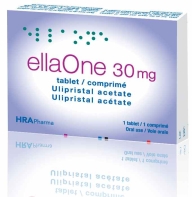The recent New York Times article by Pam Belluck, asserting that so-called abortifacient drugs may not be abortive at all, is a wonderful example of convolution of facts to obscure reality. First of all, lumping together two very different drugs and calling them “morning-after pills” allows for clever confusion of what is known about the mechanism of action of each drug, and the role of progesterone in helping the embryo to implant and sustain the pregnancy.
Plan B and Ella are very different drugs with very different mechanisms of action. Plan B is a progestin, a type of progesterone. Progesterone is a hormone that must be in a woman’s body for her to be able to allow the embryo to implant and develop the placental connections between the embryo and the mother. But Plan B is a very large dose of progesterone, higher than the woman’s body would normally make. It is the effect of that high dose which is under debate.
 Ella is a second-generation derivative of the abortion drug RU-486, and is equipotent with RU-486 in blocking the action of progesterone at the level of the ovary and endometrium, one of the facts I explain in my paper on this topic. Indeed, if taken before a woman ovulates, Ella will interfere with progesterone action and prevent the egg from being released. But the critically important question is what happens when you take Ella after ovulation. And the answer is clear. Ella blocks the action of progesterone at the level of the ovary, and blocks the action of progesterone at the endometrium, both of which interfere with implantation. Ms. Belluck is in factual error in her article.
Ella is a second-generation derivative of the abortion drug RU-486, and is equipotent with RU-486 in blocking the action of progesterone at the level of the ovary and endometrium, one of the facts I explain in my paper on this topic. Indeed, if taken before a woman ovulates, Ella will interfere with progesterone action and prevent the egg from being released. But the critically important question is what happens when you take Ella after ovulation. And the answer is clear. Ella blocks the action of progesterone at the level of the ovary, and blocks the action of progesterone at the endometrium, both of which interfere with implantation. Ms. Belluck is in factual error in her article.
The European Medical Association technical review articles state that Ella is embryocidal. That means that Ella kills embryos. I attended the FDA Advisory Committee Hearing on approval of Ella, at which data were presented which demonstrated that Ella is around 95 percent effective in preventing a clinically recognized pregnancy. One of the Advisory Committee members repeatedly pointed out to the manufacturers that there was no way the effectiveness of Ella could be explained by delaying ovulation alone. This fact does not take an FDA Advisory Committee member to figure out. If Ella works even when a woman takes it after ovulation, then of course it doesn’t work in that woman by preventing ovulation.
The same Advisory Committee member stated that the manufacturer had an even bigger problem. If you consider the pregnancies which are mentioned in the NYT article, what Ms. Belluck failed to mention is that 90 percent of those pregnancies “miscarried” and the other 10 percent were “lost to follow-up”. So what the studies supporting the FDA approval of Ella actually show is that even the dose of Ella used as “emergency contraception” is high enough to interfere with the early development of the embryo in such a fashion as to increase the miscarriage rate if a pregnancy is recognized.
And here, abortion proponents speak out of both sides of their mouth. The quote from Trussell in the NYT article was particularly amusing. If you read his previous research papers, sometimes he claims over 90 percent efficacy from Plan B, and sometimes he claims around 50 percent efficacy. Why these differences? Well, as he so readily admits, you can’t get numbers of 90 percent efficacy without some sort of post-fertilization effect. So when the issue of mechanism of action is raised, suddenly the efficacy for Plan B gets “adjusted” to what would be expected from a drug with no post-fertilization effect. But, when issues of funding arise . . . well Plan B becomes much more effective.
In point of fact, any drug which can act to prevent pregnancy after a woman has ovulated must have some post-fertilization effect. Whether it kills the embryo directly, or prevents the embryo from travelling down the tube, or prevents the embryo from implanting, or interferes with ovarian function, or increases immune rejection of the embryo, or directly destroys the placenta, some mechanism must be in place to interfere with the normal embryo functioning and then kill the living embryo.
And, because some physicians and scientists stubbornly adhere to the principles of Hippocratic medicine, and refuse to give a drug which will kill one of their patients (the human embryo), and may harm the other (the mother) the controversy will not go away.
LifeNews.com Note: Donna Harrison, M.D., is an obstetrician-gynecologist in southwestern Michigan and past-president of the American Association of Pro-Life Obstetricians and Gynecologists. Clarke Forsythe is senior counsel for Americans United for Life, and author of Politics for the Greatest Good: The Case for Prudence in the Public Square.







